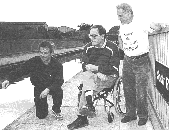
Page mirrored at Ceptual Institute, November 1998
| THE INTEGRITY PAPERS | Genre Group - Alwyn Scott | ceptualinstitute.com |

Page mirrored at Ceptual Institute, November 1998
On Wednesday 12 July 1995, an international gathering of scientists witnessed a re-creation of the famous 1834 'first' sighting of a soliton or solitary wave on the Union Canal near Edinburgh. They were attending a conference on nonlinear waves in physics and biology at Heriot-Watt University, near the canal.
The occasion was part of a ceremony to name a new aqueduct after John Scott Russell, the Scottish scientist who made the original observation. The aqueduct carries the Union Canal over the Edinburgh City Bypass.

ENLARGE Alwyn Scott
naming the aqueduct with Chris Eilbeck and
Laura Kruskal looking on.

ENLARGE Setting up the experimental apparatus on the Scott Russell
Aqueduct.

ENLARGE Chris Eilbeck, Alwyn Scott and Martin
Kruskal looking for a soliton.
In 1834, John Scott Russell was observing a boat being drawn along 'rapidly' by a pair of horses. When the boat suddenly stopped Scott Russell noticed that the bow wave continued forward "at great velocity, assuming the form of a large solitary elevation, a well-defined heap of water which continued its course along the channel apparently without change of form or diminution of speed". Intrigued, the young scientist followed the wave on horseback as it rolled on at about eight or nine miles an hour, but after a chase of one or two miles he lost it.
 MID SIZE or FULL SIZE
MID SIZE or FULL SIZE
The Soliton.
Scott Russell was convinced that he had observed an important phenomenon, and he built an experimental tank in his garden to continue his studies of what he dubbed the 'Wave of Translation'. Unfortunately the implications which so excited him (he described the day he made his original observations as the happiest of his life) were ill-understood and largely ignored by his contemporaries, and Scott Russell was remembered instead for his considerable successes in ship hull design, and for conducting the first experimental study of the 'Doppler shift' of sound frequency as a train passes.
The 'Wave of Translation' itself was regarded as a curiosity until the 1960s when scientists began to use modern digital computers to study non-linear wave propagation. Then an explosion of activity occurred when it was discovered that many phenomena in physics, electronics and biology can be described by the mathematical and physical theory of the 'soliton', as Scott Russell's wave is now known. This work has continued and currently includes modelling high temperature superconductors and energy transport in DNA, as well as in the development of new mathematical techniques and concepts underpinning further developments.
After a delay which would probably be unacceptable to present day funding bodies, and in a field he could never have dreamed of, Scott Russell's observations and research of 160 years ago have hit the big time in the present day fibre-optic communications industry. The qualities of the soliton wave which excited him (the fact that it does not break up, spread out or lose strength over distance) make it ideal for fibre-optic communications networks where billions of solitons per second carry information down fibre circuits for cable TV, telephone and computers ("The secrets of everlasting life", New Scientist 15 April 1995). It is fitting that a fibre-optic cable linking Edinburgh and Glasgow now runs beneath the very tow-path from which John Scott Russell made his initial observations, and along the aqueduct which now bears his name.
-->More on Scott Russell and the solitary wave
Last updated 15 Nov 1995 (JCE) Page mirrored at Ceptual Institute, November 1998
Dugald Duncan/Heriot-Watt University,

THE INTEGRITY PAPERS (links to CEPTUAL READINGS)
GENRE WORKS (other writers)
POETICS
MINDWAYS (links to GLOBAL THINKERS)